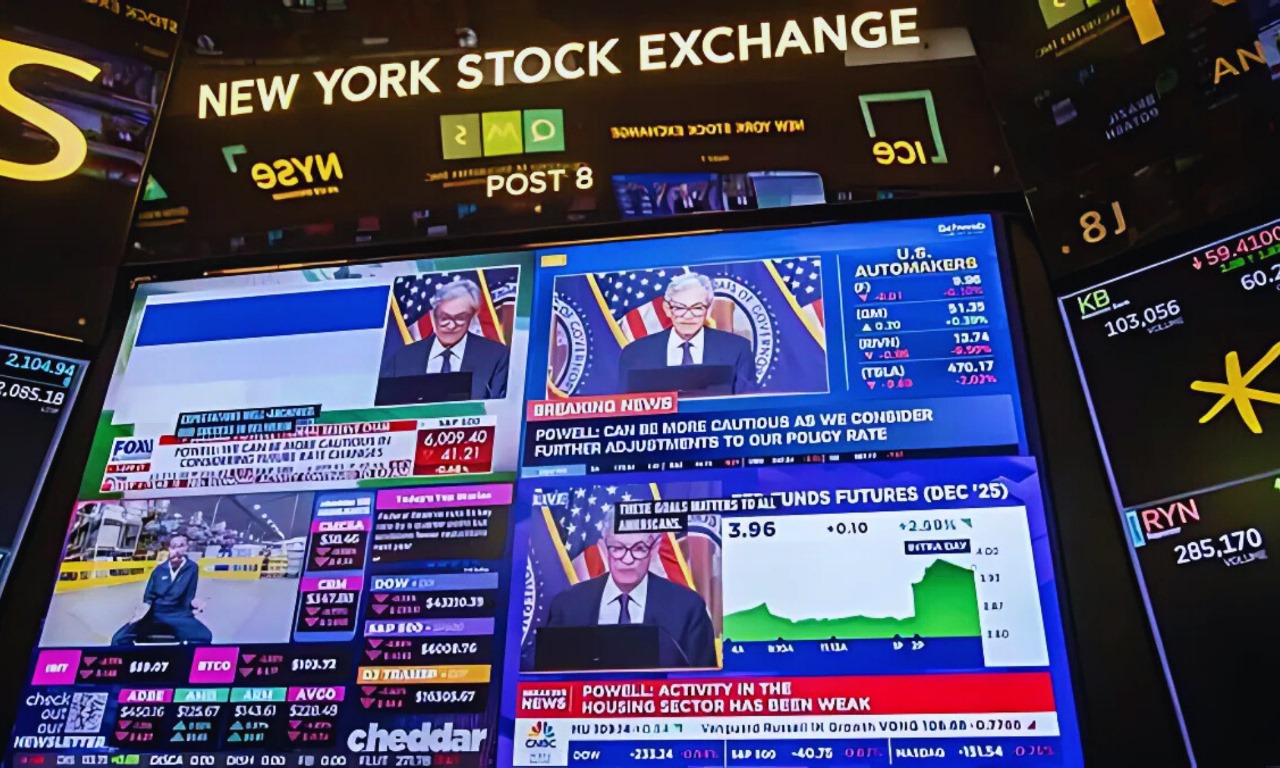Dow Plunges 1,100 Points Amid Fed’s Rate Cut Caution, Marking Worst Day Since August

The Dow Jones Industrial Average fell by 1,100 points, marking a 2.6% drop—its worst day since August—and extended its losing streak to 10 consecutive days. This represents the longest streak of daily losses for the index since 1974.
The decline also marked only the second time in 2024 that the 30-stock index has dropped by over 1,000 points in a single session.
The S&P 500 dropped 3%, slipping below 6,000, while the Nasdaq tumbled 3.6%, ending the day well below 20,000. For the S&P 500, this was the worst Federal Reserve policy day since 2001.
Fed’s Rate Cuts Fail to Reassure Markets
Although the Federal Reserve cut interest rates by 25 basis points as expected, it also announced plans to reduce rates only twice in 2025, instead of the four cuts previously forecasted.
“We need to see progress on inflation,” Fed Chair Jerome Powell stated. “That is how we are thinking about it. It is kind of a new thing. We moved quickly to get to here but moving forward we are moving slower.”
The two-year U.S. Treasury yield surged by 10 basis points to 4.35%, and the 10-year rate climbed to its highest level since May. Bloomberg’s dollar index rose to its highest point since November 2022.
Concerns Over Tariffs and Economic Impact
During Wednesday’s briefing, Powell noted that some policymakers were beginning to factor in the potential effects of higher tariffs that President-elect Donald Trump may introduce.
However, Powell described the impact of such proposals as uncertain. Max Gokhman, senior vice president at Franklin Templeton Investment Solutions, described Powell as “a hawk in dove’s clothing.”
“Despite playing down the recent slowdown in disinflation while boasting about the strength of economic momentum, he still hinted that tariffs won’t be written off as transitory and that the two-cut forecast for 2025 is necessary because policy must remain restrictive,” Gokhman said.
Whitney Watson of Goldman Sachs Asset Management suggested that the Fed may skip a rate cut in January but resume easing in March. “While the Fed opted to round out the year with a third consecutive cut, its New Year’s resolution appears to be for a more gradual pace of easing,” said Watson.
Dow’s Technical Indicators Show Key Levels
The Dow, which recently broke above the 45,000 level on December 4 following a post-election rally, has since shed nearly 1,600 points.
Despite this slump, the index remains up 15% in 2024, though it lags behind the S&P 500’s 27% gain and the Nasdaq’s 34% jump due to its smaller exposure to mega-cap tech stocks.
The index’s chart shows it has been trading within an ascending channel since late July, encountering resistance at the upper trendline.
The Relative Strength Index (RSI) confirms weakening momentum, though a similar RSI reading in October preceded a 6% rally over the next seven trading sessions.
Key support levels to monitor include the 43,300 area, which aligns with the channel’s lower trendline, the 50-day moving average, and the October and November swing points.
A breakdown below this level could see the Dow fall to 41,600, with extended losses potentially testing the psychological 40,000 mark.
Market Outlook Following Fed Policy Day
During upswings, investors are eyeing the 45,000 level as a critical resistance point near the Dow’s all-time high.
Futures for the Dow Jones, S&P 500, and Nasdaq indicated slight recoveries on Thursday, signaling potential stabilization after Wednesday’s sell-off. However, the market remains on edge.
Economic Data and Global Developments
The 10-year Treasury yield reached a five-month high of 4.54%, reflecting heightened investor concern. Meanwhile, the Bank of Japan kept its interest rates at 0.25%, leading to a weakening yen.
The Bank of England also held rates steady at 4.75%, with some members advocating for cuts.
Late Wednesday, President-elect Donald Trump’s opposition to a continuing resolution raised the risk of a government shutdown, adding to market uncertainty. Tesla CEO Elon Musk, a key Trump ally, also expressed concerns over the resolution.
Sector Highlights Amid Market Turmoil
Major stocks reacted differently to the market conditions. Micron Technology saw a sharp decline on weak guidance, while Nvidia and Tesla managed slight gains.
Vertex Pharmaceuticals plunged after a midstage study for its non-opioid drug failed to outperform a placebo. Tesla, despite selling off during the broader market downturn, showed resilience by holding above all its moving averages.







